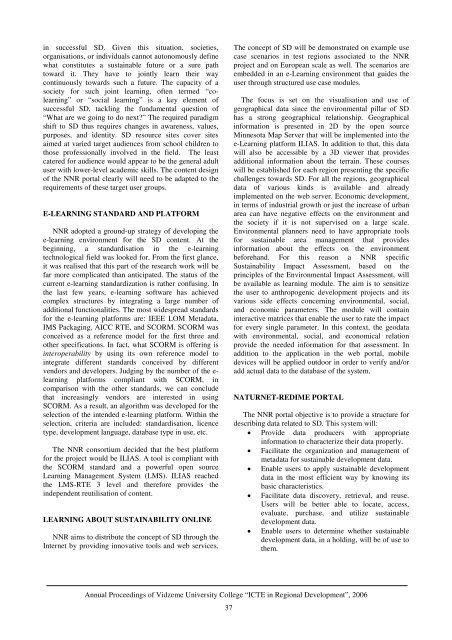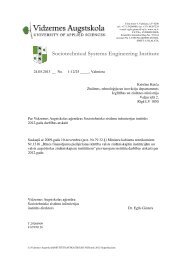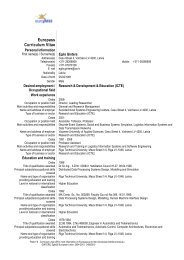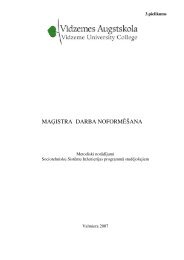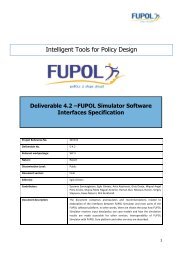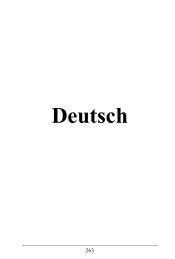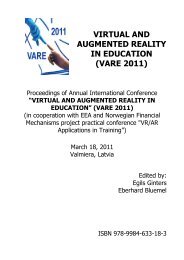NATURNET PORT – NEW SOLUTION FOR E-LEARNING AND M-LEARNING IN SUSTAINABLEDEVELOPMENT BASED ON INTEROPERABLE WEB SERVICESKarel Charvat 1 , Petr Horak 1 , Peter Barz 2, Harald Stelzl 3 , Alexander Almer 3 , Markus Jochum 4 , Maris Alberts 51 Czech Centrum for Science and Society, Praha 150 00 Czech Republic2 Environmental Network, Aboyne AB34 4TJ, Scotland, UK.3 Joanneum Research – Institute of Digital Image Process<strong>in</strong>g, Graz A-8010, Austria4 Ludwigs Albert University, Freiburg 79085, Germany5 Institute of Mathematics and Computer Science, University of Latvia, Riga LV-1459, LatviaKEYWORDSSusta<strong>in</strong>able development knowledge management,elearn<strong>in</strong>g, qualitative reason<strong>in</strong>g, metadata, thesaurus.ABSTRACTNaturNet-Redime develops educational programmestowards implement<strong>in</strong>g the European Union’s Strategy forSusta<strong>in</strong>able Development (SSD). The prototypetechnology produced demonstrates the utility of ourapproach for develop<strong>in</strong>g educational programmes that<strong>in</strong>creases understand<strong>in</strong>g of susta<strong>in</strong>able development andthe tools used to make decisions that affect susta<strong>in</strong>abledevelopment. Example content stresses awareness ofenvironmental, economic, and social factors. Asrecognized by the SSD, this <strong>in</strong>creased understand<strong>in</strong>g willallow more <strong>in</strong>formed and equitable decisions to be madeby <strong>in</strong>creas<strong>in</strong>g public <strong>in</strong>volvement <strong>in</strong> the decision-mak<strong>in</strong>gprocess. All educational; materials of the project will beavailable via the NaturNet-Redime web portal, whereusers will f<strong>in</strong>d appropriate learn<strong>in</strong>g objects to lead themthrough the learn<strong>in</strong>g process. Interaction with end usersthroughout the project provides feedback to the projectpartners to ensure that the tools are optimised.INTRODUCTIONThe ma<strong>in</strong> concept of Susta<strong>in</strong>able Development (SD)is development that meets the needs of the presentwithout compromis<strong>in</strong>g the ability of future generations tomeet their own needs (United Nations, 1987). SD thusaims to balance the effects of the <strong>in</strong>teract<strong>in</strong>genvironmental, social, and economic systems. TheEuropean Strategy for SD tries to distribute and <strong>in</strong>culcatethe concept of SD and supports particularly electronicmedia such as the Internet that offer new ways oflearn<strong>in</strong>g to promote better understand<strong>in</strong>g of thosedependencies among citizens. Exist<strong>in</strong>g SD <strong>in</strong><strong>format</strong>ionresources on the Internet focus from the local to thenational, supra-national and global levels and arecharacterized by their sheer quantity – a search for theterms “susta<strong>in</strong>ability” and “susta<strong>in</strong>able development”alone generates several million resources on the Internet.With sub-topics such as SD <strong>in</strong> agriculture, forestry,environmental science, politics, economics, urbandevelopment etc., as well as items <strong>in</strong> other languages andmedia, these numbers <strong>in</strong>crease exponentially. Theseresources call for organisation, and focussedpresentation, as the complexity and comprehensivenessof the subject require the new user to show somedeterm<strong>in</strong>ation to actually get to them and spend sometime learn<strong>in</strong>g how best to utilise them.The general objective of NaturNet-Redime (NNR) isto support the European Strategy for SD by improv<strong>in</strong>gknowledge about all aspects of susta<strong>in</strong>ability and provideeducation ma<strong>in</strong>ly about the social, economic, andenvironmental tools for the implementation of the EUStrategy on SD at both EU and <strong>in</strong>ternational levels. Thereare two ma<strong>in</strong> approaches of the NNR project, whichorig<strong>in</strong>ate from the two proposals that have merged tocreate the comb<strong>in</strong>ed project. The first an <strong>in</strong>teroperableInternet architecture, which focuses on <strong>in</strong>novativepresentation of different tools and data sources forlearn<strong>in</strong>g about susta<strong>in</strong>ability. The second is learn<strong>in</strong>gthrough modell<strong>in</strong>g, where learners develop a deepunderstand<strong>in</strong>g of causes and effects by develop<strong>in</strong>g andexplor<strong>in</strong>g models of SD situations us<strong>in</strong>g QualitativeReason<strong>in</strong>g. Both approaches will be accessible to thepublic via the NNR portal (www.naturnet.org).SUSTAINABLE DEVELOPMENT AND E-LEARNING SUSTAINABLE DEVELOPMENTSD is adaptive, cont<strong>in</strong>uous and has no fixed endpo<strong>in</strong>t.SD tends to be most focused on situations where jo<strong>in</strong>taction is needed to ensure the common good for presentand future generations. In addition, s<strong>in</strong>ce <strong>in</strong>terventions<strong>in</strong>volve the creation, identification and, above all,societal shar<strong>in</strong>g of risks that scientific and other expertisecannot reliably predict or prevent, they have added astrong impetus towards wider public participation <strong>in</strong>decisions on SD. The result of such factors is that SD hasa strong collective element <strong>in</strong> it, and the capacity ofsocieties for such collective action is an important factorAnnual <strong>Proceed<strong>in</strong>gs</strong> of Vidzeme University College “ICTE <strong>in</strong> Regional Development”, 200636
<strong>in</strong> successful SD. Given this situation, societies,organisations, or <strong>in</strong>dividuals cannot autonomously def<strong>in</strong>ewhat constitutes a susta<strong>in</strong>able future or a sure pathtoward it. They have to jo<strong>in</strong>tly learn their waycont<strong>in</strong>uously towards such a future. The capacity of asociety for such jo<strong>in</strong>t learn<strong>in</strong>g, often termed “colearn<strong>in</strong>g”or “social learn<strong>in</strong>g” is a key element ofsuccessful SD, tackl<strong>in</strong>g the fundamental question of“What are we go<strong>in</strong>g to do next?” The required paradigmshift to SD thus requires changes <strong>in</strong> awareness, values,purposes, and identity. SD resource sites cover sitesaimed at varied target audiences from school children tothose professionally <strong>in</strong>volved <strong>in</strong> the field. The leastcatered for audience would appear to be the general adultuser with lower-level academic skills. The content designof the NNR portal clearly will need to be adapted to therequirements of these target user groups.E-LEARNING STANDARD AND PLATFORMNNR adopted a ground-up strategy of develop<strong>in</strong>g thee-learn<strong>in</strong>g environment for the SD content. At thebeg<strong>in</strong>n<strong>in</strong>g, a standardisation <strong>in</strong> the e-learn<strong>in</strong>gtechnological field was looked for. From the first glance,it was realised that this part of the research work will befar more complicated than anticipated. The status of thecurrent e-learn<strong>in</strong>g standardization is rather confus<strong>in</strong>g. Inthe last few years, e-learn<strong>in</strong>g software has achievedcomplex structures by <strong>in</strong>tegrat<strong>in</strong>g a large number ofadditional functionalities. The most widespread standardsfor the e-learn<strong>in</strong>g platforms are: IEEE LOM Metadata,IMS Packag<strong>in</strong>g, AICC RTE, and SCORM. SCORM wasconceived as a reference model for the first three andother specifications. In fact, what SCORM is offer<strong>in</strong>g is<strong>in</strong>teroperability by us<strong>in</strong>g its own reference model to<strong>in</strong>tegrate different standards conceived by differentvendors and developers. Judg<strong>in</strong>g by the number of the e-learn<strong>in</strong>g platforms compliant with SCORM, <strong>in</strong>comparison with the other standards, we can concludethat <strong>in</strong>creas<strong>in</strong>gly vendors are <strong>in</strong>terested <strong>in</strong> us<strong>in</strong>gSCORM. As a result, an algorithm was developed for theselection of the <strong>in</strong>tended e-learn<strong>in</strong>g platform. With<strong>in</strong> theselection, criteria are <strong>in</strong>cluded: standardisation, licencetype, development language, database type <strong>in</strong> use, etc.The NNR consortium decided that the best platformfor the project would be ILIAS. A tool is compliant withthe SCORM standard and a powerful open sourceLearn<strong>in</strong>g Management System (LMS). ILIAS reachedthe LMS-RTE 3 level and therefore provides the<strong>in</strong>dependent reutilisation of content.LEARNING ABOUT SUSTAINABILITY ONLINENNR aims to distribute the concept of SD through theInternet by provid<strong>in</strong>g <strong>in</strong>novative tools and web services.The concept of SD will be demonstrated on example usecase scenarios <strong>in</strong> test regions associated to the NNRproject and on European scale as well. The scenarios areembedded <strong>in</strong> an e-Learn<strong>in</strong>g environment that guides theuser through structured use case modules.The focus is set on the visualisation and use ofgeographical data s<strong>in</strong>ce the environmental pillar of SDhas a strong geographical relationship. Geographical<strong>in</strong><strong>format</strong>ion is presented <strong>in</strong> 2D by the open sourceM<strong>in</strong>nesota Map Server that will be implemented <strong>in</strong>to thee-Learn<strong>in</strong>g platform ILIAS. In addition to that, this datawill also be accessible by a 3D viewer that providesadditional <strong>in</strong><strong>format</strong>ion about the terra<strong>in</strong>. These courseswill be established for each region present<strong>in</strong>g the specificchallenges towards SD. For all the regions, geographicaldata of various k<strong>in</strong>ds is available and alreadyimplemented on the web server. Economic development,<strong>in</strong> terms of <strong>in</strong>dustrial growth or just the <strong>in</strong>crease of urbanarea can have negative effects on the environment andthe society if it is not supervised on a large scale.Environmental planners need to have appropriate toolsfor susta<strong>in</strong>able area management that provides<strong>in</strong><strong>format</strong>ion about the effects on the environmentbeforehand. For this reason a NNR specificSusta<strong>in</strong>ability Impact Assessment, based on thepr<strong>in</strong>ciples of the Environmental Impact Assessment, willbe available as learn<strong>in</strong>g module. The aim is to sensitizethe user to anthropogenic development projects and itsvarious side effects concern<strong>in</strong>g environmental, social,and economic parameters. The module will conta<strong>in</strong><strong>in</strong>teractive matrices that enable the user to rate the impactfor every s<strong>in</strong>gle parameter. In this context, the geodatawith environmental, social, and economical relationprovide the needed <strong>in</strong><strong>format</strong>ion for that assessment. Inaddition to the application <strong>in</strong> the web portal, mobiledevices will be applied outdoor <strong>in</strong> order to verify and/oradd actual data to the database of the system.NATURNET-REDIME PORTALThe NNR portal objective is to provide a structure fordescrib<strong>in</strong>g data related to SD. This system will:• Provide data producers with appropriate<strong>in</strong><strong>format</strong>ion to characterize their data properly.• Facilitate the organization and management ofmetadata for susta<strong>in</strong>able development data.• Enable users to apply susta<strong>in</strong>able developmentdata <strong>in</strong> the most efficient way by know<strong>in</strong>g itsbasic characteristics.• Facilitate data discovery, retrieval, and reuse.Users will be better able to locate, access,evaluate, purchase, and utilize susta<strong>in</strong>abledevelopment data.• Enable users to determ<strong>in</strong>e whether susta<strong>in</strong>abledevelopment data, <strong>in</strong> a hold<strong>in</strong>g, will be of use tothem.Annual <strong>Proceed<strong>in</strong>gs</strong> of Vidzeme University College “ICTE <strong>in</strong> Regional Development”, 200637
- Page 1 and 2: ISBN 9984-633-03-9Annual Proceeding
- Page 3 and 4: “Development of Creative Human -
- Page 5 and 6: TABLE OF CONTENTSINTELLIGENT SYSTEM
- Page 7 and 8: INTELLIGENT SYSTEM FOR LEARNERS’
- Page 9 and 10: LEARNER 1GROUP OF HUMAN AGENTSLEARN
- Page 11 and 12: QuantityQuantityFigure 6. Distribut
- Page 13 and 14: LEARNERStructure of theconcept mapL
- Page 15 and 16: WEB-BASED INTELLIGENT TUTORING SYST
- Page 17 and 18: materials to be presented and which
- Page 19 and 20: INFORMATION TECHNOLOGIES AND E-LEAR
- Page 21 and 22: correspondence with the course aim
- Page 23 and 24: projects and through IT. Hence, it
- Page 25 and 26: APPLICATION OF MODELING METHODS IN
- Page 27 and 28: can support configuration managemen
- Page 29 and 30: The EKD is one of the Enterprise mo
- Page 31 and 32: CHANGES TO TRAINING AND PERSPECTIVE
- Page 33 and 34: or an end, yet none of these attitu
- Page 35 and 36: make decisions. It cannot be volunt
- Page 37 and 38: logs), data and video conferencing
- Page 39 and 40: Ability to follow user’s multi-ta
- Page 41: CONCLUSIONSEDUSA method gives us a
- Page 45 and 46: SPATIAL INFORMATIONFor the visualis
- Page 47 and 48: MOBILE TECHNOLOGIES USE IN SERVICES
- Page 49 and 50: learning environment (Learning Mana
- Page 51 and 52: ago only some curricula on Logistic
- Page 53 and 54: The Web-based version can be access
- Page 55 and 56: Web-portal, which incorporates diff
- Page 57 and 58: DO INTELLIGENT OBJECTS AUTOMATICALL
- Page 59 and 60: Table 1. Examples for introducing R
- Page 61 and 62: workable influencing of the process
- Page 63 and 64: are handed over to the objects and
- Page 65 and 66: • Basic processes, such as wareho
- Page 67 and 68: THE ECR E-COACH: A VIRTUAL COACHING
- Page 69 and 70: participating in the workshops and
- Page 71 and 72: • Assessment modules enable indiv
- Page 73 and 74: with pictures and illustrated graph
- Page 75 and 76: ECR Question Banknumber category su
- Page 77 and 78: educational programme that follows
- Page 79 and 80: DEVELOPMENT OF WEB BASED GRAVITY MO
- Page 81 and 82: These results of a model require a
- Page 83 and 84: CONCLUSIONSThe main goal of work ha
- Page 85 and 86: dimension and included within any o
- Page 87 and 88: • Resources sharing by providing
- Page 89 and 90: Pursuant to the guidelines of elect
- Page 91 and 92: tariffs of regulated services have
- Page 93 and 94:
INFORMATION TECHNOLOGY FOR MOTIVATI
- Page 95 and 96:
difficult to predict when and for w
- Page 97 and 98:
Listeners' workon the WebListenersS
- Page 99 and 100:
PERSPECTIVES OF WEB PAGE AND E-MAIL
- Page 101 and 102:
INCREASE IN THE NUMBER OF INTERNETU
- Page 103 and 104:
tourism accommodations (home pages
- Page 105 and 106:
interactive relationships with clie
- Page 107 and 108:
• The data obtained by the resear
- Page 109 and 110:
Central Statistical Bureau of Latvi
- Page 111 and 112:
departures for 1995 are taken from
- Page 113 and 114:
120100maximumworldminimum806040200-
- Page 115 and 116:
140120maximumworldminimum1008060402
- Page 117 and 118:
would be a promising extension. Cur
- Page 119 and 120:
AN OVERVIEW OF THE AGENT − BASED
- Page 121 and 122:
Suitability for social system simul
- Page 123 and 124:
6. MASONDescription:MASON is a fast
- Page 125 and 126:
Suitability for social system simul
- Page 127 and 128:
could be bad particularly when over
- Page 129 and 130:
(for 10 repeat &| CCar[]->runfor);P
- Page 131 and 132:
• Streaming audio• Collaboratio
- Page 133 and 134:
NECESSITY OF NEW LAYERED APPROACH T
- Page 135 and 136:
Up to now, there has only been limi
- Page 137 and 138:
aaaaa6= −aa2,1 = − a0,3226= −
- Page 139 and 140:
∂ u∂x∂ u∂y2 2+ b = 02 2wher
- Page 141 and 142:
a6,3= −2030a4,5−130a4,3- - - -
- Page 143 and 144:
0,10,20,30,4( )Mag x y y Ge wx2, =
- Page 145 and 146:
Example 1. To understand better the
- Page 147 and 148:
Therefore, further the following co
- Page 149 and 150:
SOLUTION OF THE THREE-DIMENSIONALEQ
- Page 151 and 152:
Mag1, m , m , m1 2 3= mm1 m2m32 2 2
- Page 153 and 154:
MagMag0, m , m , m1 2 31, m , m , m
- Page 155:
CONCLUSIONSThe basic content of thi


